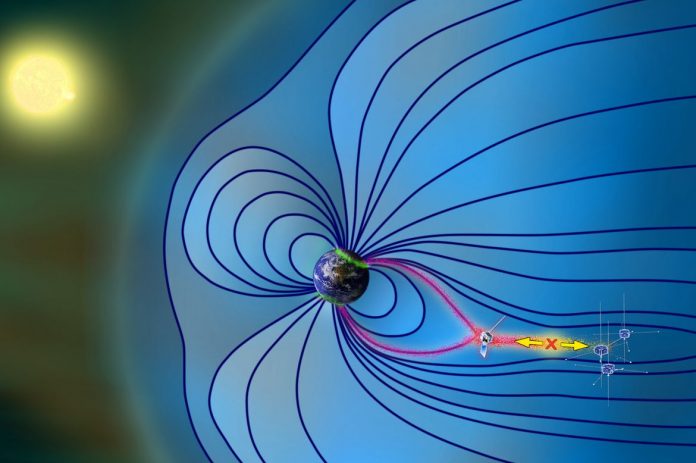Beyond Earth’s atmosphere are swirling clouds of energized particles — ions and electrons — that emanate from the sun. This “solar wind” buffets the magnetosphere, the magnetic force field that surrounds Earth.
In much the same way winds and storms create weather in our atmosphere, strong gusts of solar wind penetrating the magnetosphere can generate magnetic storms with powerful electric currents that can impact our lives.
A new study by the NASA THEMIS mission team — led by Vassilis Angelopoulos, a UCLA professor of space physics — is the first to show that such storms can originate much closer to Earth than previously thought, overlapping with the orbits of critical weather, communications and GPS satellites. The team’s findings are published in the journal Nature Physics.
Magnetic storms can produce dazzling northern lights or hazardous particles careening toward spacecraft and astronauts, zapping them out of commission. Under certain conditions, magnetic storms can disable the electrical grid, disrupt radio communications and corrode pipelines, even creating extreme aurora visible close to the equator.
“By studying the magnetosphere, we improve our chances of dealing with the greatest hazard to humanity venturing into space: storms powered by the sun,” Angelopoulos said.
An incident that illustrates the dramatic power of magnetic storms occurred in 1921, when such a storm disrupted telegraph communications and caused power outages that resulted in a New York City train station burning to the ground. And in 1972 the Apollo 16 and 17 astronauts narrowly missed what could have been a lethal solar eruption. These incidents underscore the potential dangers that should be assessed as more humans venture into orbit. If a similar storm occurred today, a separate study estimated, economic losses in the U.S. due to electrical blackouts only could surpass $40 billion a day.
How electric currents in space influence the aurora and magnetic storms has been long debated in the space physics community. Because the storms occur so rarely and satellite coverage is sparse, it has been difficult for researchers to detect the dynamic process that powers those storms.
When solar wind magnetic energy is transferred into the magnetosphere, it builds up until it is converted into heat and particle acceleration through a process called magnetic reconnection. After decades of study, it is still unclear to researchers where exactly magnetic reconnection occurs during storms.
Recent observations by multiple satellites have shown that magnetic storms can be initiated by magnetic reconnection much closer to Earth than previously thought possible. The three NASA THEMIS satellites observed magnetic reconnection only about three to four Earth diameters away. The researchers did not expect this could happen in the comparatively stable magnetic field configuration near Earth.
Later, a weather satellite, which was nearer to Earth in geostationary orbit, detected energized particles associated with magnetic storms.
The weather satellite proved that this near-Earth reconnection stimulated ion and electron acceleration to high energies, posing a hazard to hundreds of satellites operating in this common orbit. Such particles can damage electronics and human DNA, increasing the risk of radiation poisoning and cancer for astronauts. Some particles can even enter the atmosphere and affect airline passengers.
“Only with such direct measurements of magnetic reconnection and its resulting energy flows could we convincingly prove such an unexpected mechanism of storm power generation,” said Angelopoulos, who is lead author of the paper. “Capturing this rare event, nearer to Earth than ever detected before, forces us to revise prior assumptions about the reconnection process.”
This discovery will ultimately help scientists refine predictive models of how the magnetosphere responds to solar wind, providing precious extra hours or even days to prepare satellites, astronauts and the energy grid for the next “big one” in space.















